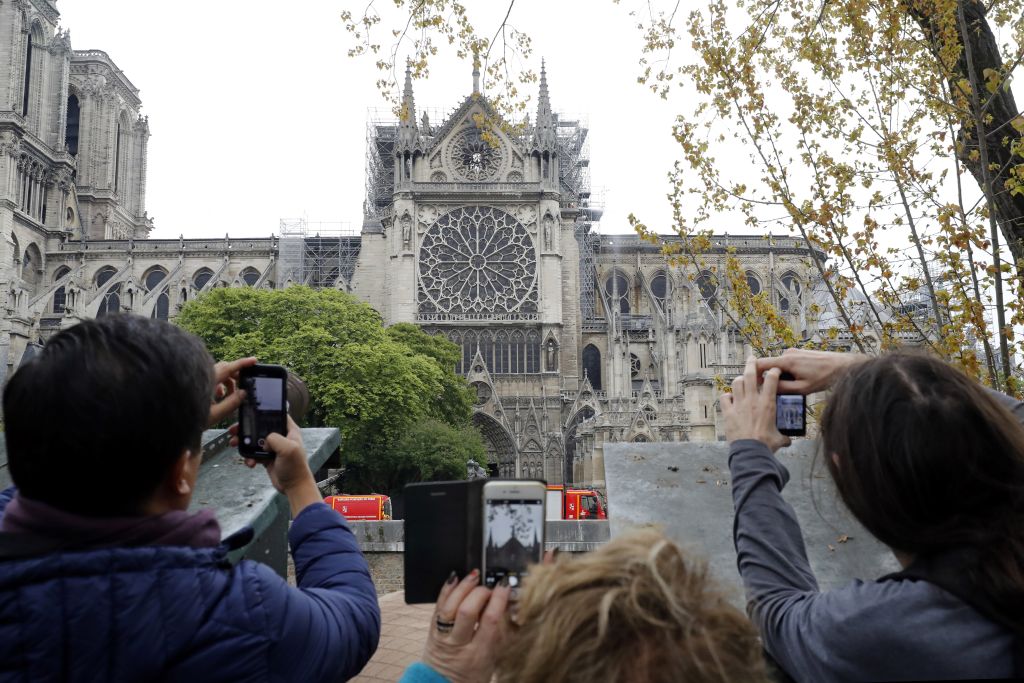Notre-Dame is the symbolic heart of Paris and France, and a symbol of European Christianity second only to the Vatican in Rome. The apocalyptic destruction of a monument of such beauty and significance would be a sign of the times at any time. In our time, however, no one seems sure of what the sign means.
I doubt I was alone in my first response. When I saw footage of the falling, burning spire, I assumed that this was an act of terrorism rather than, as seems most likely, an accident caused by renovation work. This is a sign of the times, even though it would be incautious to admit it in polite society.
It is vital to establish the cause of the fire, because it is also a sign of the times that the vandalism of French churches has lately reached a level reminiscent of the French Revolution. In February alone, The Tablet reported, 47 churches were attacked. At Saint-Alan cathedral in Lavaur, crosses and statues of saints were smashed, and the altar cloth burned. At Notre-Dame des Enfants in Nîmes, the altar was looted, and a cross and communion wafers desecrated with human excrement. At Saint-Denis near Paris, where the bones of French kings and queens are interred, vandals smashed stained glass windows, an organ, and choir stalls. In mid-March, an arsonist attached Saint Sulpice in Paris. These are not symptoms of a healthy civilization.
Ellen Fantini, executive director of the Observatory on Intolerance and Discrimination against Christians in Europe, told The Tablet that republican, anticlerical France is ‘the worst country in Europe’ for ‘secularist, anti-religious intolerance’. Fantini identified a wave of what The Tablet called ‘anti-Christian actions by anarchist, feminist and Islamist movements’. Only two of those movements could be called secularist and anti-religious.
It is a further sign of the times that, before yesterday’s fire, some of Notre Dame’s 30,000 daily visitors were buying tickets to its famous bell tower at €8.50, while its owner, the French state, had allowed its structure and fabric to deteriorate. Its limestone was stained and eroded by rain, wind and pollution, and in some places was crumbling to the touch. Pieces of masonry, including one of the famous gargoyles, had fallen off the building. Water was leaking into the flying buttresses and wood-framed spire. With cracks appearing in the facade, conservationists warned that the stained glass windows could collapse in the event of a storm. In 2017, cathedral spokesman André Finot described the decay as ‘spinning out of control’.
The French state has doubled its annual maintenance budget to €4 million. But the estimated restoration costs were closer to €100 million. It is a sign of the times that the state, the doyenne of dirigisme, had abandoned the saving of Notre Dame to private charity, and that, in a Western Europe where Christianity is in sharp decline, foreign money is seen as crucial to the cathedral’s survival. In 2013, private donors funded its nine new bells. In 2014, Russia helped to pay for the cathedral’s Christmas tree, because the parish could not afford it. In 2016, the Archbishop of Paris and the Diocese of Paris launched The Friends of Notre Dame, with heavy emphasis on the friendship of Americans. Emmanuel Macron’s announcement that the reconstruction funding would include the soliciting of international donations confirms this outsourcing of the maintenance of France’s heritage.
It is another sign of the times that the first responders on Twitter could not agree what yesterday’s fire means. ‘My thoughts are with the people of France as a masterpiece of European Gothic is at risk of being destroyed,’ tweeted the EU’s chief Brexit negotiator, Guy Verhofstadt. Just his thoughts; not his prayers. Nothing about Christianity or Western civilization, either; just the concern of a connoisseur of flying buttresses.
Amid the tweetstorm of distress, a regiment of American comedians joked about publicity programming for the new series of Game of Thrones. While Notre-Dame went up in flames, they played at making montages in which the burning cathedral was a backdrop to the face of an actress, or a slogan about the imminence of winter. Are our historical imaginations wholly shaped by tourism and violent entertainment?
This would be a sign that Westerners are losing their sense of history, and their sense of reality. The societies of western Europe certainly appear to be losing their sense of purpose along with their religion. Before yesterday’s fire, France exemplified that crisis. Like the stones of Notre Dame, France’s economy and society have been allowed to decay. The social contract is crumbling amid the violence of Islamists, neofascists and communists, and the mixed motley of gilets jaunes rioting over taxes and cuts. Macron said yesterday that it was France’s ‘profound destiny’ to restore the cathedral. But he is as shallow as men of destiny get, and has already lost his footing in the waters of populism.
The civilization of western Europe, Kenneth Clark said, survived the collapse of the western Roman Empire ‘by the skin of our teeth’. The modern heirs to the builders of Notre Dame are in better shape materially, but the restored Notre Dame may, unless monuments of similar significance are damaged, be one of Europe’s last Christian public works. When it reopens, it will be even more of a museum, and even less of a shrine. It is right of Emmanuel Macron to commit resources to its reconstruction, but it’s not as if he has any choice. Imagine how Marine Le Pen’s share of the vote would rise if he didn’t. And that too is a sign of the times.
Dominic Green is Life & Arts Editor of Spectator USA.


















